 Regia Marina: 8 Built 1929-33: Folgore, Lampo, Fulmine, Baleno
Regia Marina: 8 Built 1929-33: Folgore, Lampo, Fulmine, BalenoWW2 Italian Destroyers
Poerio | Aquila | Mirabello | Leone | Sella | Sauro | Turbine | Navigatori | Freccia | Folgore | Maestrale | Oriani | Soldati | Medaglie d’OroWW2 Italian Torpedo Boats
Indomito | Audace | Audace(ii) | Pilo | Sirtori | La Masa | Generali | Palestro | Curtatone | Albatros | Spica | Pegaso | Ciclone | ArieteThe Folgore class, sometimes mixed with the Dardo class, was composed of four ships, all modern and fast Italian destroyers largely based on the Freccia class (or Dardo class). It was built with a structure similar to that of the previous “Dardo”, but with some improvements. The biggest change was the use of a doubled firing station, in order to engage two different targets, through the two twin Ansaldo 120mm/50 Mod with 1926 turrets, twin, mounted one in the same configuration. Two were ordered to the Cantieri Bacini e Scali Partenopei in Naples and the other two at the Quarnaro shipyard in Fiume. All four went though a few improvements in armament and had a load of 52 mines, all inserted.
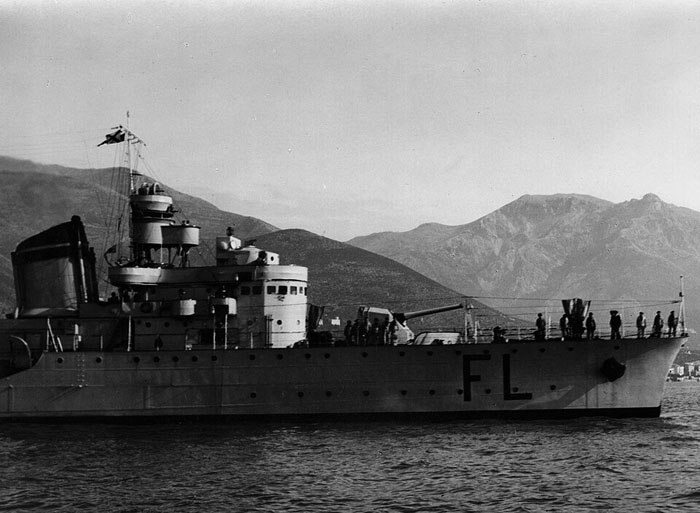
Design of the Freccia class
Development
There is not much to say about the Folgore class, that was in short, a copy-paste of the Freccia class; The latter inaugurated a brand new design if Italian destroyer, readical departure since the 1920 Palestro class which had the first, twon mounts for their main guns. After a serie of 2-funneles destroyers, the Sella, Sauro and Turbine, and with the one-of-a-kind scouts of the “Navigatori” class, the Freccia were seen an an all-out improvement of the Turbine, with a single funnel, rearrangement machinery, more output, more range, different bridge, new fire control and beefed up AA armament. Basically, they laid the basis for a whole serie spanning until 1943, comprising the Folgore, Maestrale, Oriani, and Soldati classes.
They weere all very similar and only differed in minor details.
The Folgore class for their part were modified Freccia with a beam reduced to try to regain some speed, a factor lost on the Freccia, which were frustrating on sea trials. This was a second attempt to reach their initially required top speed in 1928. The beam was in fact the same as for the Turbine class. However this meant sacrificing stowage capacity, notably oil. As a result, their radius of action suffered, going down to 3600 nm at 12 knots. But this overall was turned not to be a success, with little speed increase while retaining the faults of the Freccias. They also needed modifications to make them more stable, reinforce the hull and ballasting it, thus further reducing speed and range. Later modification followed that of the Freccias.
On the next Maestrale class, great care in calculations were done, and new basin trials in order to determinate a more appropriate shape and this was a success, mostly. The machiner type and layout was more efficient and there was a slight increase in speed, stability and seaworthiness. A part of development confirmed with the Oriani and matured with the 1938, larger and treaty-defiant Soldati class (1700-1800 tonnes standards).
In service, like their predecessors, the Folgore saw heavy action. One was foundered in 1941 and the others were sunk in action in 1941, 42 and 1943. None survived the war.

Hull and general design
The Folgore class were very close in general layout and design with an overall length of 96.05 meters (315 ft 1 in) with a beam of 9.2 meters (30 ft 2 in) and mean draft of 3.3 meters (10 ft 10 in), or deep draught of 4.3 meters (14 ft 1 in). They displaced 1,238 metric tons (1,218 long tons) standard, 2,090 metric tons (2,060 long tons) deep load. complement amounted to 185 officers and ratings.
Powerplant
The Folgore class destroyer were powered by two Belluzzo geared steam turbines, driving a propeller shaft, with th steam supplied by three Thornycroft boilers. The turbines were rated at 44,000 shaft horsepower (33,000 kW), providing a top speed of 30 knots (56 km/h; 35 mph) in service. On sea trials as usual they topped 38–39 knots (70–72 km/h; 44–45 mph) on light load. They carried fuel oil for a range of 3,600 nautical miles (6,700 km; 4,100 mi) at a speed of 12 knots (22 km/h; 14 mph).
Armament of the Folgore class
The Folgore class were armed the same way as the Freccia class. They had two twin 120 mm (4.7 in) guns on the same mounts and two single 40 mm (1.6 in) AA guns plus two twin 13.2 mm (0.52 in) Breda heavy machine guns. The two triple 533 mm (21 in) torpedo tubes were also part of the package, located at the same place. She had two depth charge throwers, and she carried 52 mines.
Cannone da 120mm/50 OTO Modello 1931
Mount: 5.1 tons (5,552 kg), 252.0 in (6.400 m)
Shell: Separate, 23 kg AP, HE 51.8 lbs. (23.15 kg).
Propellant: 21.4 lbs. (9.7 kg)
Muzzle Velocity: 3,117 fps (950 mps) Later reduced to 3,018 fps (920 mps)
Range: 19,600 m
Rate of fire: 6-7 rounds per minute
The Navigatori were provided 182 rounds per gun so 1092 total. Standard outfit was 408 AP, 672 HE, 120 incendiary and 100 star shells, plus an unspecified number of ready rounds.
Fire Control
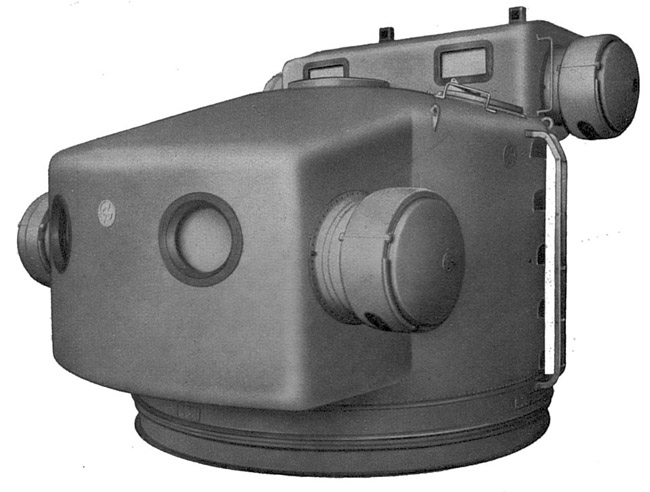
For the first time, Italian destroyers were fitted with a modern fire control system, inspired by the Navigatori class. Fire direction was optimized for daytime actions, with two three meters (10 in) Officine Galileo/Zeiss stereoscopic rangefinders. One set was on a platform aft of the bridge, with the main tower on the bridge’s roof containing the San Giorgio general aiming system. There was a second Zeiss/San Giorgio rangefinder positioned on the intermediary platfrom between TT banks. Night-time firing systems were only installed on some units well into WW2. Also, a San Giorgio kinematic teleinclinometer was placed under the crow’s nest. This was a considerable improvement over the previous Turbine class, and somewhat compensated by a loss in accuracy.
2-in (40mm/39) Vickers-Terni M1917
The anti-aircraft armament initially comprised the same two Vickers-Terni 1915 40mm/39 machine guns placed on either side on the forecastle, next to the forefunnel, as well as four Breda 13.2 mm machine guns in two twin mounts on the bridge’s wings, like the Turbine class.
Specs Vickers-Terni 1915:
Weight 550 lbs. (249 kg) including cooling water
Overall lenght 96 in (2.438 m), bore 62 in (1.575 m), 200 rpm cyclical, 50-75 rpm practical
Fired the HE or CP rounds of 2.95 lbs. (1.34 kg) at 2,000 fps (610 mps).
Maximum Effective Range: 1,200 yards (1,100 m)
Specs 13.2 mm Breda HMG:
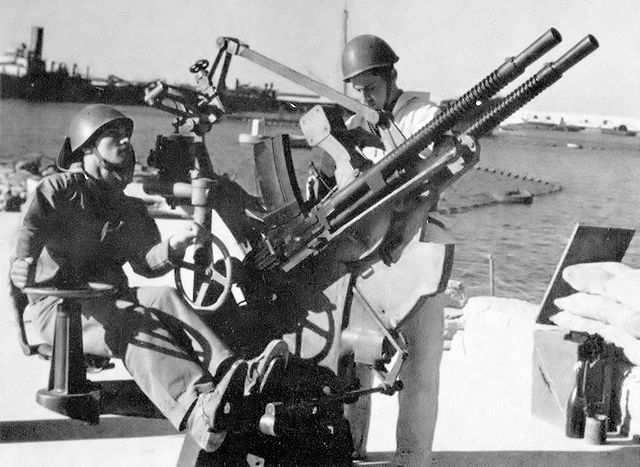
Specs (Modello 1931)
Gun Weight: 104.5 lbs. (47.5 kg), Bore Length 39.4 in (1.000 m). 500 rounds per minute cyclic.
Fired 5.4 in (13.7 cm) 0.28 lbs. (0.125 kg) rounds at 2,592 fps (790 mps), effective range: 2,200 yards (2,000 m).
533 mm Torpedoes
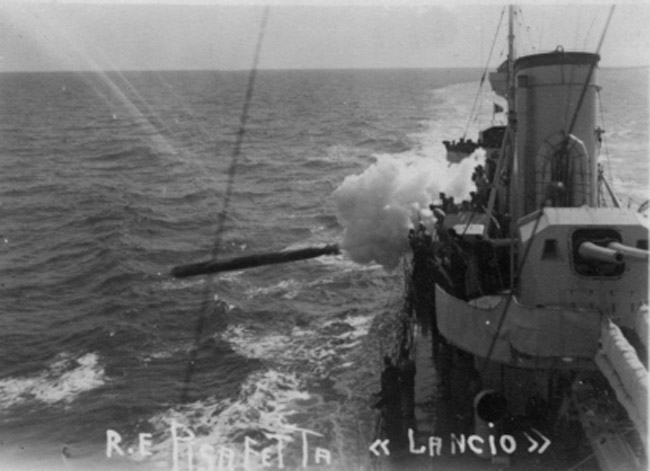
The ships like previous destroyers, were given the same two triple in-line torpedo launchers, 533 mm, San Giorgio type. They were placed in the axis, one between the two funnels and the second behind the aft funnel. The aiming was electrically controlled by the Fire Direction system and its two stations:
-One for daytime launching, located in the crow’s nest
-One for night launching, on the bridge.
They were likely given the 53.3 cm (21″) Si 270/533.4 x 7.2 “M” model. This was a model manufactured in Naples (Silurificio Italiano).
There were no reloads.
Specs:
Weight; 3,748 lbs. (1,700 kg)
Overall Length: 23 ft. 7 in. (7.200 m)
Warhead: 595 lbs. (270 kg)
Range/Speed settings: 4,400 yards (4,000 m)/46 kts, 8,750 yards (8,000 m)/35 kts, 13,100 yards (12,000 m)/29 kts
Powered by Wet-heater. Later versions went to 48/38/30 knots on the same ranges settings.
Ginocchio ASW Torpedo
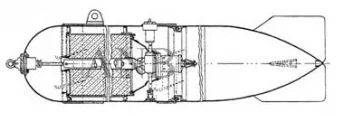 Underwater Weapons Directorate of La Spezia, table dated September 1931, longitudinal section src
Underwater Weapons Directorate of La Spezia, table dated September 1931, longitudinal section src
In the original design, the ships carried a Ginocchio “towing torpedo” GP1927/46 T. It was eliminated in 1940. Developed in the 1930s, it was a promising new device. These weapons were used during the First World War by light units such as MAS. It could be towed at variable speeds from 2 to 20 knots, could dive to depths ranging from 17 to 33 m. Depending on the length of the towing cable, maintaining a predetermined immersion, they were ready to explode due to the impact effect or thanks to an electrical ignition circuit.
Modified and improved after the WW2, the modello 46/1927 type GP (great depth) had a 46 kg charge, automatic trigger, and became widespread on torpedo boats and VAS ships. See also.
ASW Grenades
Two racks were there from the start, but two launchers were installed at the stern in 1939-40 for the launch of 50 and 100 kg depth charges. Stocks were later strengthened with more modern charges, some of which were German WB D of 125 kg and WB F of 60 kg as well as 30 kg “intimidatory” bombs, which were a warning charge to force a submarine to surface.
The launchers were trainable mortars used to project 100 kg (220 lbs.) DCs, normally fired at a 45 degree angle.
The standard depth charges while in servicee were likely the following:
B TG Monc. 50/1927 4 Reg. (1927): 110 lbs. (50 kg) for 20, 40, 70 and 100 m (65, 130, 230 and 330 feet).
B TG Monc. 100/1927 4 Reg. (1927): 220 lbs. (100 kg) for 25, 50, 75 and 100 m (80, 165, 250 and 330 feet).
B TG Monc. 50/1936 (1936): 141 lbs. (64 kg) or 110 lbs. (50 kg), unknown settings.
Mines
For minelaying all units were equipped with rails, and could carry up to 54 Vickers-Elia mines (760 kg) or 56 Bollo mines (590 kg). During the war, seven ships had their rails lengthened to lay 86 mines of the P.200 type or 104 Bollo type, and German antenna mines.
-Vickers Elia (VE) 1,676 lbs. (760 kg), 320 lbs. (145 kg) WH
-Bollo Mines
Paravanes
For protection in 1940, type C paravanes were mounted at the stern of all ships. They were lowered down via their lattice support gear arms, but once in water, they created a strong reduction in agility by the drag they created, reducing their practical use. They were however were detrimental to stability and removed in 1942.
Smoke Projectors
To complement protection, all Freccia class destroyers were equipped with admiralty type type smoke generators, placed at the base of the funnels, in complement to the diesels located aft on the starboard side. Later in WW2 they were replaced by more efficient chlorohydrin systems.
Profile planned
⚙ specifications as built |
|
| Displacement | 1,220 long tons (1,240 t) standard, 2,100 long tons (2,100 t) full load |
| Dimensions | 95.9 x 9.2 x 3.3-4.5m (314 ft 8 in x 30 ft 2 in x 10 ft 10 in – 14 ft 9 in) |
| Propulsion | 2 shafts; 2 GST, 3 Thornycroft boilers, 44,000 hp (33,000 kW) |
| Speed | 30 knots (56km/h; 35mph) |
| Range | 3,600 nmi (6,700 km; 4,100 mi) at 12 knots (22 km/h; 14 mph) |
| Armament | 2×2 120 mm (4.7 in), 2× 40 mm (1.6 in), 4×2 13.2 mm (0.52 in), 2×3 533 mm (21 in), 2 DCT, 52 mines |
| Crew | 185 |
Sensors
During the war, the The Folgore class came with an echo sounder in addition to classic hydrophones. However no radar was mounted albeit some sources states at some point in 1943, Lampo received a German Fu.Mo.24, but certainly not the Italian-made EC3/ter “Gufo”. However they were equipped in early ore mid-1942 by a German “Metox” radar-detector. It should be assumed none ever received a radar.
Modifications
During the 1939 – 1940 refit, they all saw the removal of two 40mm/39, two twin 13.2mm (0.5 in)/76 for from five to six single 20mm/65 Breda 1939/1940 autocannons.
During their 1942 refit, Folgore and Lampo saw the removal of a triple 533mm Torpedo Tube Bank. Instead, two single 37mm/54 Breda 1939 autocannons were added.
General Evaluation
The Folgore class was sometimes called a 2nd series Dardo (Freccia) class. Attempt to raise speed at the expense of hull beam was paid by a fall of endurance, and they still suffered from insufficient stability, further aggravated with their smaller hull beam. A pump system was installed to gradually substitute fuel with seawater and stow 100t of dry ballast for a standard displacement going from 1220 to 1450t, speed down to 31-32kts. In combat, their AA was efficient. One even sank a submarine, but between their primitive sonar and great speed, they were unable to detect British submarines while in convoy. Most were sunk in classic naval surface engagement, where they were often let down but their lack of long range detection and were overwhelmed often by naval gunfire. A single hit could disable their machinery, decapitate their bridge or reduce by half their armament, in one lucky hit. Meanwing in three major hits, especially from 6-in shells, they were toast. Restrospectively a bad design, that was slightly corrected but never completely. The wartime Soldati class still reproduced the same compromised design, albeit with better stability, seaworthiness, speed and range. The real solution was planned in 1938 as the Medaglie d’Oro class, coming out with a better single-mount dual purpose artillery, and extra AA, speed and range, but they were never completed.
Four additional ships of a modified design were also sold to Turkey, in response of the ones built for the Greeks. This was the Tinaztepe-class, similar except their two funnels as built by Cantiere navale di Riva Trigoso. The next Adatepe-class destroyers were altered with four single guns rather than two twin and lengthened to compensate, as built by Ansaldo in Genoa. They will be seen on naval encyclopedia in 2026 or 2027.
Career of the Folgore class
 Folgore (1931)
Folgore (1931)
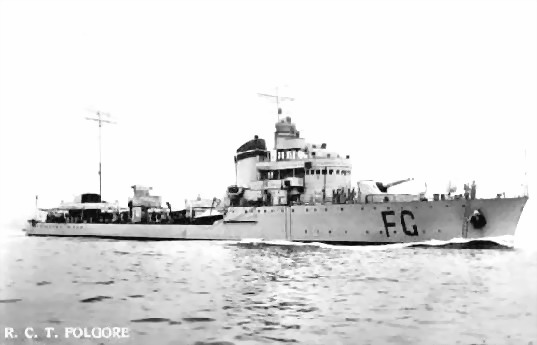
Folgore (FG) was laid down on january 1930 at Bacini & Scali Napoletani, Napoli (OCP), launched on 26 april 1931, and commmissioned on 1 july 1932. Once in service she became leader of the VIII Destroyer Squadron with Fulmine, Lampo and Baleno. No logs for her prewar career. At 14.10 on 7 July 1940 she left Taranto with her sisters to escort Giulio Cesare and Conte di Cavour teaming with the 7th DS (Freccia class) in support of a convoy to Libya (troop transports Esperia, Calitea; Marco Foscarini, Francesco Barbaro and Vettor Pisani) with a vanguard made of the TBs Orsa, Procione, Orione, Pegaso, Abba and Pilo. They later joined the I and II Naval Squadron, and fought at the battle of Punta Stilo on 9 July.
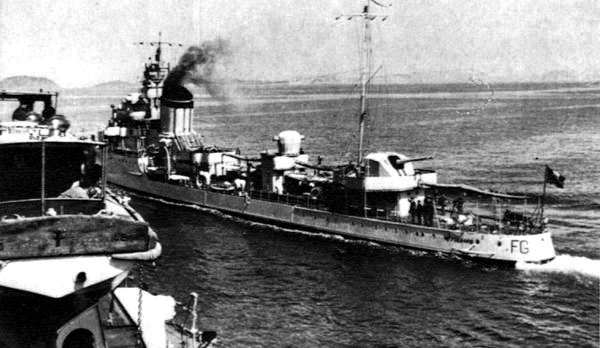
In 1941 she swapped MGs for six Breda 20 mm machine guns. Her sisters did the same. On 9 January she shells with Ascari, Fulmine and Carabiniere, Greek positions at Porto Palermo. On 5 March she was part of a convoy from Naples to Palermo and Libya. On 28 March, same to Tripoli, with Dardo and Strale (Utmost sank Heraklea, damaged Ruhr). On 21-24 April she escorted another Naples-Tripoli convoy and on 1 May a convoy ambushed by HMS Upholder (Arcturus, Leverkusen lost). On 16 May she escorted another Naples-Tripoli which arrived on the 21st.
On 21 July she was escort leader for a convoy (with Fulmine, Saetta and Euro) Naples-Tripoli (4 transports and tanker Brarena, DD Fuciliere, TB Pallade). They were attacked by Fairey Swordfish from 830 Sqn off Pantelleria (Preussen and Brarena gone).
On 13 August, she started another Naples-Tripoli (with Vivaldi, Malocello, Strale, Fulmine, TB Orsa, 5 transports). They arrived despite air attacks (Vivaldi lost).
On September 1st, she departed for another Naples-Trpoli (with Recco, Dardo, Strale, 5 transports) atacked on the 3rd by aircraft (Andrea Gritti lost, Francesco Barbaro damaged).
On 5 September she left Tripoli for Naples (DDs Da Recco, Freccia, Strale, TB Circe, 2 transport, 1 oiler) and on 7 September Ernesto was damaged by O 21 off Pantelleria towed to Naples.
On 24 September now reassigned to the XIV DS (with Da Recco and Pessagno), she left Naples with Vittorio Veneto and Littorio and the 13th DS to intercept a British convoy but failed.
On 16-19 October 1941 another Naples-Tripoli (5 transports, Beppe damaged by HMS Ursula Caterina lost after air attack). On 3 March 1942 she was damaged in an air raid in Palermo. On 14 June she left Taranto with a squadron comprising Littorio and Vittorio Veneto, Trento and Gorizia, light cruisers Garibaldi and Duca d’Aosta and 12 destroyers to counter Operation Vigorous (Battle of mid-June). Later she escorted the convoy «Monviso». She was overhauled and received extra AA and a «Metox» radar detector antenna to at least detect the presence of other radar equipped vessels.
On 3-5 August she escorted a convoy to Tobruk and Benghazi. The transports carried 92 tanks, 340 vehicles, 3 locomotives, a crane and 292 soldiers, 4381 t of fuel and oils, 5256 t of foord and other supplies). She sailed with the DDs Corsaro, Legionario, Freccia, Grecale and Turbine, TBs Partenope and Calliope. They fended off air attacks notably from US B-24 Liberator.
On 27 August she was hit and damaged by an air attack in port. On 4 October at midnight she left Brindisi in escort (plus Zeno, TB Antares, DDs Saetta, Camicia Nera) to escort the Sestriere to Benghazi, again with a precious reinforcement cargo. US bombers could not prevent their arrival on 7 October.
On 12 October, she left Brindisi with Da Recco and TB Ardito and Clio, escorting the D’Annunzio, joining another from Corfu, reaching port unscathed on the 14th. Folgore had some wounded on board by the air attacks. She left with Sestriere and Ruhr in return, no issue.

On 4 November, another escort to Tripoli, unscathed. On 26 November same to Bizerta, detached to recover survivors from Circe (rammed and sunk by Città di Tunisi).
On November 28 she left Bizerta with Città di Napoli (mine as presumed, sank off Capo San Vito Siculo).
On 2 December, she left Palermo under command of Ener Bettica to Palermo for convoy “H”. Via Ultra, Force Q (HMS Aurora, Sirius Argonaut, DDs Quentin, Quiber) was sent in interceptio, and spotted them at 00.37 off Skerki Bank, Tunisian coast. The fight lasted for an hour. All the transports were sunk except Puccini, badly damaged, latter scuttled. Da Recco and Procione were badly damaged, Folgore, astern of the convoy, detected them with «Metox» and Aldo Cocchia of flagship Da Recco ordered to counterattack. She ran to 1000 m of HMS Aurora under smoke, launched three torpedoes, then her last three on HMS Sirius, but missed. Then she opened fire and was hit in returned 9 times by Sirious’s 6-in guns (152 mm) mostly. She ended dead in the war, on fire but still firing until all ammunition was exhausted. At 1.16, she capsized and sank with half the crew. Commander Bettica stayed in the bridge and went down as well, posthumously awared the Gold Medal for Military Valor. She made 155 missions over 56,578 miles.
 Lampo (1931)
Lampo (1931)

Lampo (LA,LP) was laid down on january 1930 at Bacini & Scali Napoletani, Napoli, launched on 26 july 1931 and commissioned on 13 august 1932. She was assigned to the VIII Destroyer Squadron. By the autumn of 1936, she took part in Spanish Civil War patrols against Republican freighters or suspected republican smugglers. On 23 November 1938, she was accidentally rammed by Pola in an exercise. Serious damage as Lampo lost her bow, with repairs until 22 May 1939.
At 14.10 on 7 July 1940, she left left Taranto for a mission that ended with the battle of Punta Stilo on 9 July. She was modified in Janury 1941. On March 5, she made her first escort mission (with Folgore, Noli, Vivaldi and Malocello) for 4 German transports to Libya. On March 12, from Tripoli to Naples. On March 27, her convoy that was ambushed by HMS Utmost (Heraklea sunk, Ruhr damaged).
On 13 April, she left Naples under under her new captain, LtCdr. E. Marano to Tripoli with Lampo and Tarigo (convoy «Tarigo») with Arta, Adana, Aegina, Iserlohn and Sabaudia and a large cargo for the Afrikakorps. On 14-15th the convoy was dispersed by bad weather, recomposed, spotted by British recce aircraft and at 2.20 on 16 April, off the Kerkenna shoals, HMS Jervis, HMS Janus, HMS Nubian and HMS Mohawk. The battle saw the destruction of Luca Tarigo, and the transports Sabaudia, Aegina, Iserlohn, with the Mohawk being torpedoed by Tarigo. Arta, Adana and Baleno were blasted by fire and ran to the shore, they ended up stranded on the shoals. Lampo when the attack commenced was sailing alongside the convoy, and was the first to report the attackers and to be shelled. She fired three three salvos and launch torpedoes but was hit many times. Her funnel was torn open by a shell, she lost her 120 mm aft mount, had her boilers pierced, hull holed and lost a lot of men. She ended in flames from stem to stern, unable to steer until she ran aground, at 5:AM, 6.5 miles of the Kerkenna shoals. Her crew flooded her ammunition stores to avoid detonation. She settled on the seabed, deck emerging slightly. She was abandoned by 64 out of a crew of 205, showing the severity of her damage. All the others were killed by the four destroyers concentrating on her.
On 4 July, the rescue ship Epomeo approached the wreck and bodies remaining on board for a proper burial at sea.
On 8 August work started to recover her and three days later she was refloated and towed to Palermo by the Artiglio II, then to Naples, and La Spezia, Genoa in dry dock for the mother of all repairs, from 21 September 1941 to 18 May 1942. She was also modernized and rearmed. Amazingly she was back in service from September 1942, escorting three convoys to Tobruk, and Suda with latter seeing one transport torpedoed by HMS Umbra and sank off Navarino. At midnight on 12 October she left Corfu to escort, the Foscolo, joined a convoy to destination on the 14th, despite allied air attacks. Next she escorted Sestriere and Ruhr back, same.
On 28-29 November 1942, under command of LtCdr Cuzzaniti, on Taranto-Palermo, she ecorted Da Recco, the steamer Anna Maria Gualdi, tanker Giorgio to Palermo unharmed (air attack still).
On 1 December 1942 she left Palermo with a tanker for Tunis. Hit by aircraft she was towed by Lampo brought and ran aground near Trapani, fire stopped and she was towed to Palermo.
On the 2nd, she sailed to the Skerki Bank in rescue of the battle between convoy H and Force Q. On 28 December she escorted the transport Gran when torpedoed by HMS Ursula.
On 17 February 1943 she escorted the Col di Lana, sunk by torpedo bombers. Nor rescue as she had to dodge the same and escape. On 22 February she rescued survivors from the German Gerd, sunk off Skerki Bank. On 30 April 1943, 11:AM from Trapani under LtCdr Loris Albanese, she carried 52 tons of ammunition, stowed at the bow and stern, to Tunis. In the firce air attack, she was hit by several bombs and caught fire. Ammunition stores were flooded to prevent explosion but she listed until abandoned, and later finished off by a second air attack at 19:12, 6 miles from Ras Mustafa, Tunisian coast with 60 men out of 213 crew. She survived an amazing amount of desstruction and was rebuilt for a second round and a total of 137 missions over 36,651 miles. Her rzpairs lasted for a record 502 days. With a largest industrial basis, not doubt she would have been left a wreck, but Italy was deseperate at this point, and ready to go the extra mile of a long range towing extensive repairs of a ship that had been utterly savaged to the bone.
 Fulmine (1931)
Fulmine (1931)

Fulmine and Saetta leaving port in 1938
Fulmine (FN,FL) was laid down on october 1929 at Cantieri del Quarnaro, Fiume, Napoli, launched on 2 august 1931 and commissioned on 14 september 1932. In 1937-1938 she took part in the Spanish Civil War. She was assigned in 1940 to the VIII Destroyer Squadron with her sisters. On 7 July 1940 she left Taranto for what became the battle of Punta Stilo on 9 July. On 11 November she was in Taranto when Swordfish attacked the port. Herself was narrowly missed by a torpedo, which hit the Conte di Cavour right behind. Her AA gunners claimed that aircraft though, albeit Cavour claimed it their own. In January 1941 she received extra AA. On 6 January she was attached to the IX DS and shelled with other DDs from the XIV TBQ Greek military installations in Porto Palermo, Albania. On 9 January she did the same again. On 8-12 March, she escorted with Turbine and Baleno a convoy of 4 merchant ships to Tripoli. On 12 March returned trip with Arcturus and Wachtfels to Naples. 30 April she was in indirect escort (with Trieste and Bolzano, Eugenio di Savoia for 6 transports from Augusta and Messina and Libya for the Afrikakorps. They arrived unscathed despite air attacks.
Same on 5-7 May to Tripoli. Then same on May 16, from Naples to Tripoli on the 21st. She also escorted the Bosforo, Bainsizza, Duisburg and the tanker Panuco back.
On 21 July she was in escort with Folgore, Saetta and Euro (Maddalena Odero, Nicolò Odero, Caffaro and Preussen) on Naples-Tripoli. They were joined by the tanker Brarena, DD Fuciliere and TB Pallade whe attacked by Fairey Swordfish off Pantelleria (Preussen, Brarena lost).
On 13 August, Naples-Tripoli, unscathed on the 15th (Vivaldi lost). On 12 September she rescued men from Caffaro and Nicolò Odero. On 24 September she escorted a convoy claimed attacked by a submarine off Pantelleria (not confirmed).
On 16-19 October she escorted a Naples-Tripoli (transports Beppe, Marin Sanudo, Probitas, Paolina, Caterina), savaged by HMS Ursula (Caterina lost).
Battle of the Duisburg convoy:

On the morning of 8 November 1941, Fulmine (under command of LtCdr Mario Milano) left Naples to join the escort of the “Duisburg” convoy (transports Duisburg, San Marco, Sagitta, Maria, Rina Corrado, Conte di Misurata and Minatitlan, 34,473 t of supplies, 389 vehicles, 243 men) to Tripoli. She was accompanied by the Maestrale, Grecale, Libeccio, Euro and Alfredo Oriani, with the heavy cruisers Trento and Trieste, 4 destroyers in distant escort. They were intercepted by “Force K” (HMS Aurora and Penelope with the destroyers Lance and Lively. This was a one-sided fight in which the cover force was too far away to intervene (no radar). All merchantmen were sunk, Grecale suffered heavy damage and Fulmine, on the starboard side of the convoy was among the first hit. She counterattacked, launched torpedoes at long range, tried to hit HMS Lance, then Aurora and Penelope opened fire on her. She took six hits and many near misses splinter. The distance fell at some ponint to heavy machine gun range. Her engine was blasted and she lost all power. Commander Milano was seriously wounded, she lost half her armament in a single hit (showing the issue with twon mounts). The bridge fell under command of Lieutenant Giovanni Garau, the fire control director, which managed to fire eight shots. At some point the confusion was such that trigger-happy merchantmen she was supposed to protect also fired at her, unable to recoignise her. Fulmine then was devastated by the explosion of a boiler. She capsized and sank rapidly this night at 1:06 on November 9, after 12 minutes of heavy fighting. Commander Milano bled to death at sea, lieutenant Garau, voluntarily sank with the ship and half the crew (141) was gone with her. The remainder were partly picked up by the destroyer Libeccio, and lost again whe she herself was torpedoed by HMS Upholder. Commander Milano and Lieutenant Garau received later a posthumous Gold Medal for Military Valor.
In total she performed 97 missions over 29,518 miles.
 Baleno (1931)
Baleno (1931)
No image (CC)
Baleno (BO) was laid down on october 1929 at Cantieri del Quarnaro, Fiume, launched on 22 march 1933 and commissioned on 15 june 1932. Sam story as her sisters, Spanish Civil War patrols in 1936-39. In 1940 she was part of the same VIII DS as her sisters. At 1.57 on 14 June 1940, while patrolling in the Gulf of Taranto, she spotted HMS Odin, caught surfaced trying to repair her damages of the next day by Strale. She sped up and tried to ram her but Odin submerged, then Baleno dropped two depth charges and made a second pass. Hit, Odin sank with all hands.
At 14.10 on 7 July she left Taranto with her sisters in what became later the battle of Punta Stilo. She also received extra AA 1941. On 24 February 1941 she escorted Marco Polo, Conte Rosso, Esperia and Victoria on a Naples-Tripoli. She was protected in distant cover by Armando Diaz and Bande Nere, DDs Ascari and Corazziere. HMS Upright torpedoed Diaz later.
On 8 March, she escorted the auxiliary cruiser Attilio Deffenu, recovering passengers from SS Fenicia, sunk by HMS Unique. Baleno was on hunt and drove her off.
8-12 March, she escorted a convoy Tripoli, no issue. On 1 April (Naples-Tripoli) and idem. 13 April, same, but she was now under LtCdr Giuseppe Arnaud. This was the famous convoy “Tarigo”, for the Afrika Korps. n the night of 14t-15th bad weather and recomposion, the convoy was discovered by British recce, and on 16 April, intercepted off the Kerkenna shoals by a strong force of 4 destroyers. Tarigo and the transports were all sunk, as Mohawk in an epic stand. Baleno at the time was alongside the convoy, and she received a concentrated fire blasting her bridge (only survivor, chief engineer Edoardo Repetto di Borgonovo). She ended dead in the war and in flames. Her armament was also soon out of action, and most her crew dead or wounded. She ran aground on the shallows of Kerkennah, abandoned by only 37 survivors. Later she capsized and sank at sunset on April 17. She had performed 64 over 18,782 miles. Her wreck was relocated on 1950-1951 in shallow waters by the company Minio Contivecchi Recuperi, partially dismantled to recover metals.
Read More/Src
Books
Brescia, Maurizio (2012). Mussolini’s Navy: A Reference Guide to the Regina Marina 1930–45. NIP.
Campbell, John (1985). Naval Weapons of World War Two. NIP.
Fraccaroli, Aldo (1968). Italian Warships of World War II. Shepperton, UK: Ian Allan.
Roberts, John (1980). “Italy”. In Chesneau, Roger (ed.). Conway’s All the World’s Fighting Ships 1922–1946. New York: Mayflower Books.
Rohwer, Jürgen; Hümmelchen, Gerhard (2005). Chronology of the War at Sea 1939–1945: The Naval History of World War Two (3rd rev. ed.). NIP.
Whitley, M. J. (1988). Destroyers of World War 2: An International Encyclopedia. NIP.
Links
navypedia.org/ folgore.htm
trentoincina.it Fulmine
trentoincina.it/ Folgore
trentoincina.it Lampo
trentoincina.it Baleno
navypedia.org/ dd_folgore.htm
conlapelleappesaaunchiodo blogspot.com
regiamarina.net/
it.wikipedia.org/ Classe_Folgore
3D
None found
Video
None found
Model kits
https://www.subsim.com/radioroom/showthread.php?t=251944

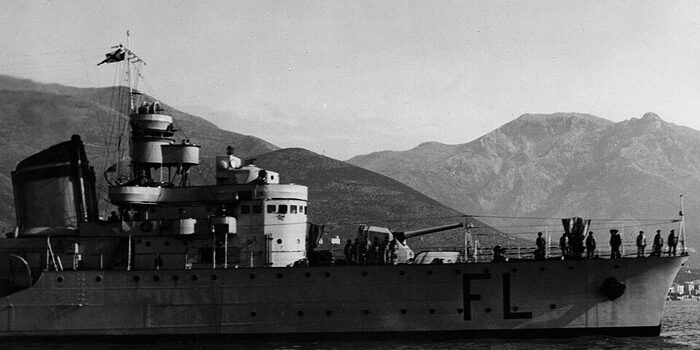
 Latest Facebook Entry -
Latest Facebook Entry -  X(Tweeter) Naval Encyclopedia's deck archive
X(Tweeter) Naval Encyclopedia's deck archive Instagram (@navalencyc)
Instagram (@navalencyc)


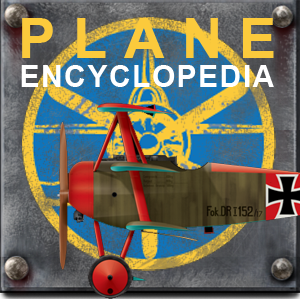
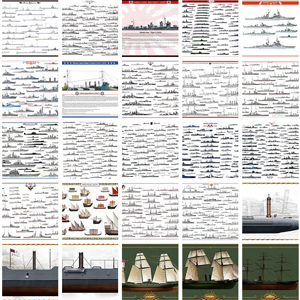

 French Navy
French Navy Royal Navy
Royal Navy Russian Navy
Russian Navy Armada Espanola
Armada Espanola Austrian Navy
Austrian Navy K.u.K. Kriegsmarine
K.u.K. Kriegsmarine Dansk Marine
Dansk Marine Nautiko Hellenon
Nautiko Hellenon Koninklije Marine 1870
Koninklije Marine 1870 Marinha do Brasil
Marinha do Brasil Osmanlı Donanması
Osmanlı Donanması Marina Do Peru
Marina Do Peru Marinha do Portugal
Marinha do Portugal Regia Marina 1870
Regia Marina 1870 Nihhon Kaigun 1870
Nihhon Kaigun 1870 Preußische Marine 1870
Preußische Marine 1870 Russkiy Flot 1870
Russkiy Flot 1870 Svenska marinen
Svenska marinen Søværnet
Søværnet Union Navy
Union Navy Confederate Navy
Confederate Navy Armada de Argentina
Armada de Argentina Imperial Chinese Navy
Imperial Chinese Navy Marinha do Portugal
Marinha do Portugal Mexico
Mexico Kaiserliche Marine
Kaiserliche Marine 1898 US Navy
1898 US Navy Sovietskiy Flot
Sovietskiy Flot Royal Canadian Navy
Royal Canadian Navy Royal Australian Navy
Royal Australian Navy RNZN Fleet
RNZN Fleet Chinese Navy 1937
Chinese Navy 1937 Kriegsmarine
Kriegsmarine Chilean Navy
Chilean Navy Danish Navy
Danish Navy Finnish Navy
Finnish Navy Hellenic Navy
Hellenic Navy Polish Navy
Polish Navy Romanian Navy
Romanian Navy Turkish Navy
Turkish Navy Royal Yugoslav Navy
Royal Yugoslav Navy Royal Thai Navy
Royal Thai Navy Minor Navies
Minor Navies Albania
Albania Austria
Austria Belgium
Belgium Columbia
Columbia Costa Rica
Costa Rica Cuba
Cuba Czechoslovakia
Czechoslovakia Dominican Republic
Dominican Republic Haiti
Haiti Hungary
Hungary Honduras
Honduras Estonia
Estonia Iceland
Iceland Eire
Eire Equador
Equador Iran
Iran Iraq
Iraq Latvia
Latvia Liberia
Liberia Lithuania
Lithuania Mandchukuo
Mandchukuo Morocco
Morocco Nicaragua
Nicaragua Persia
Persia San Salvador
San Salvador Sarawak
Sarawak Uruguay
Uruguay Venezuela
Venezuela Zanzibar
Zanzibar Warsaw Pact Navies
Warsaw Pact Navies Bulgaria
Bulgaria Hungary
Hungary

 Bundesmarine
Bundesmarine Dutch Navy
Dutch Navy Hellenic Navy
Hellenic Navy Marina Militare
Marina Militare Yugoslav Navy
Yugoslav Navy Chinese Navy
Chinese Navy Indian Navy
Indian Navy Indonesian Navy
Indonesian Navy JMSDF
JMSDF North Korean Navy
North Korean Navy Pakistani Navy
Pakistani Navy Philippines Navy
Philippines Navy ROKN
ROKN Rep. of Singapore Navy
Rep. of Singapore Navy Taiwanese Navy
Taiwanese Navy IDF Navy
IDF Navy Saudi Navy
Saudi Navy Royal New Zealand Navy
Royal New Zealand Navy Egyptian Navy
Egyptian Navy South African Navy
South African Navy






























 Ukrainian Navy
Ukrainian Navy dbodesign
dbodesign